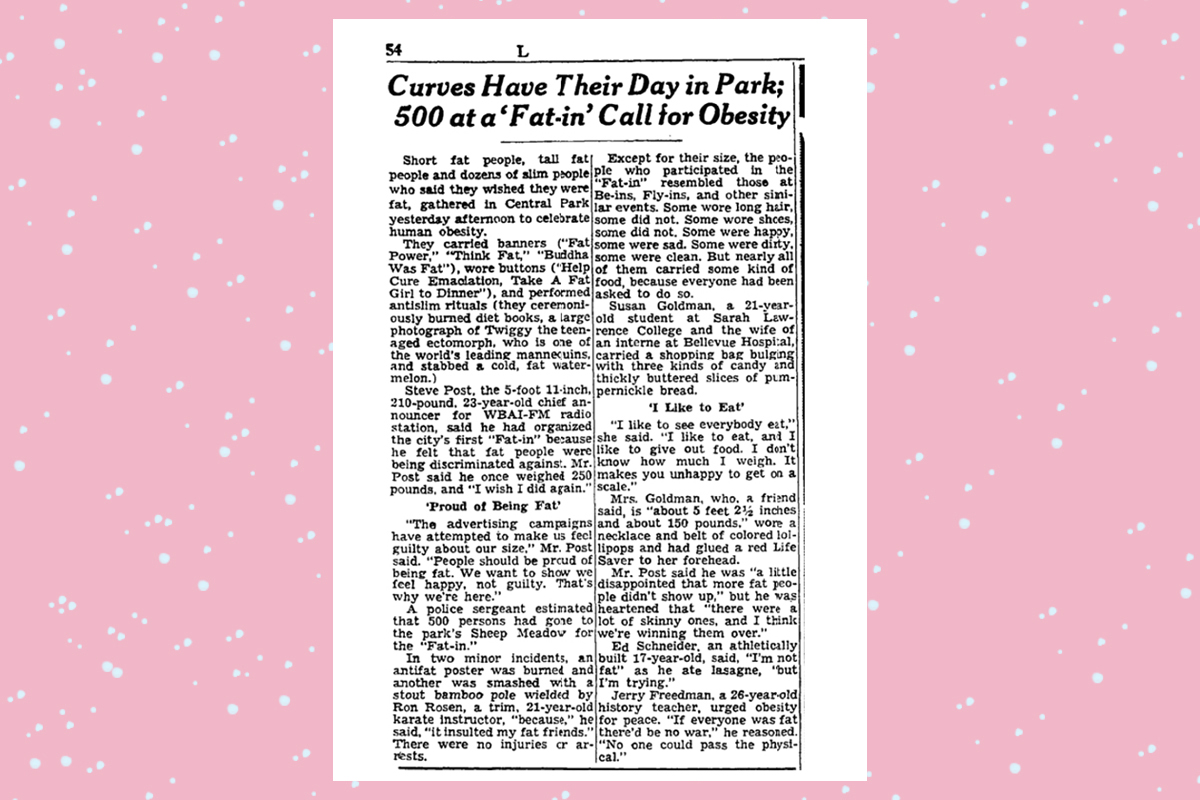Squeezed between adverts for the Broadway productions of Fiddler on the Roof and Hello Dolly was a New York Times article (dated June 5) entitled “Curves Have Their Day In Park.” The paper reported that a 500-strong crowd — composed of “short fat people, tall fat people, and dozens of slim people who said they wished they were fat” — congregated in Sheep Meadow, Central Park to celebrate obesity. Staged by 23-year-old Steve Post, this protest was dubbed the first ever “Fat-In.”
Post was most famous for being the curmudgeonly host of “Morning Music With Steve Post” on WNYC between ’82 and 2001, but he was broadcasting on WBAI-FM, a counterculture station during the “Fat-In” years. There he veered between political heckling and playing Mozart and Hendrix.
Born in the Bronx in 1944 (he passed away in 2014), he was an overweight Jewish kid with a complicated family background. By the time he hosted the Central Park event, he’d lost 40 pounds but not his sense of outrage at how he was discriminated against when at his heaviest. He told the Times, “People should be proud of being fat. We want to show we feel happy, not guilty.”

Everyone who attended the event — at the bequest of Post — carried food. Most also held up banners reading “Fat Power” and wore buttons saying “Think Fat.” Though the “Fat-In” was peaceful, the throng of protestors burned diet books and, according to the Times, “a large photograph of Twiggy the teenage ectomorph.”
The “Fat-In” was certainly a sign of the times. The 1960s was a decade of monumental counterculture movements. The coastal and college towns of America experienced waves of protests led by the Yippies, the Hippies, radical feminists, and Black, Asian and Minority Ethnic [BAME] communities, campaigning for civil rights, women’s equality, and peace in Vietnam. The “Fat-In” occurred at the start of the Summer of Love and took its name from the “Human Be-In” festival held in San Francisco that happened six months earlier.
The “Human Be-In” brought 20,000 people together to celebrate psychedelic culture, communal living, radical liberal politics, and — to put it bluntly — LSD. It inspired the “Yip-In” at Grand Central Terminal (1968), the “Love-In” in Malibu Canyon (1968), and, of course, the “Fat-In.”
Post’s protest movement may not have known it some 53 years ago, but its impact would be felt far beyond the San Fran protest from which it took its name.
Inspired by Post, William Fabrey, an engineer who was tired of the discrimination his plus-sized wife faced, founded NAAFA (the National Association to Advance Fat Acceptance, née National Association to Aid Fat Americans) in July of 1967. “I asked [Steve Post] about the Fat-In [during the 1970s], and he said that it hadn’t been serious activism… but I told him that it had been inspiring anyway to me (as NAAFA’s founder) and to author Lew Louderback, who wrote Fat Power, and was a NAAFA co-founder as well,” Fabrey wrote on the Obesity Time Bomb blog.
As a nationwide group, NAAFA staged plus-size fashion shows and events opposing diets and skinny privilege. It protested for equal rights for all sizes.
Newly graduated from the counter-culture movement, Radical Therapy Collective, which critiqued how mental health was treated in the 1970s, was two West Coast Jewish NAAFA members, Sara Fishman and Judy Freespirit (born Judith Louise Berkowitz Ackerman). They attempted to bring a feminist spin to the group. “From the start, our small NAAFA chapter took a confrontational stance with regard to the health professions,” Fishman wrote in a 1988 article for Radiance Magazine. “We accused them — doctors, psychologists, and public health officials — of concealing and distorting the facts about fat that were contained in their own professional research journals. In doing so, they betrayed us and played into the hands of the multibillion-dollar weight-loss industry, which exploits fear of fat and contempt toward fat people as a means to make more money.”
Picketing television networks and harassing local weight-loss institutions caused ripples of unrest in NAAFA. Deemed too militant, the West Coast contingent splintered and the Fat Underground was founded in 1972.

“It is no accident that Hollywood, purveyor to the world (via cinema) of the thesis that only the slender deserve respect, also produced its first radical antithesis: the Fat Underground,” Fishman said. “The Fat Underground employed slashing rhetoric: Doctors are the enemy. Weight loss is genocide. Friends in the mainstream, sympathetic academics and others in the early fat rights movement urged them to tone it down, but ultimately came to adopt much of the Fat Underground’s underlying logic as their own.”
Less than a decade after Post’s “Fat-In,” Fishman and Freespirit, along with collaborators Ariana Manow, Shri Gram, and Gudrun Fonfa, would see their protest group reach its peak. In August 1974, weeks after Jewish Mamas and Papas singer Cass Elliot’s premature death, the Fat Underground publicly and poetically eulogised Elliot at a Women’s Equality Day event in Los Angeles.
“We carried candles and wore black arm bands, in a symbolic funeral procession,” remembers Fishman. Taking to the stage, the Fat Underground praised Elliot for representing them, for being a fat woman “who had refused to hide her beauty.” They ended their sermon by accusing the medical establishment of murdering Cass, and “committing genocide against fat women.”
It’s not a total coincidence that the founding fathers (and mothers) of the body positivity movement were Jewish. Whether it’s hamantaschen at Purim, doughnuts at Hanukkah, or the sanctified seder meal at Passover, food plays a significant role in the religion. Its importance is stated with every nuanced dish prepared for the High Holidays — even Yom Kippur, where the restriction of it (to allow for spiritual purging) only further reiterates what food means to Judaism and Jews.
A journalist for the Los Angeles Jewish Journal, David Margolis noted in 2001, that among other things: “A lot of people also consider fat a Jewish issue.” He asserted that Jewish people tended to treat food like others did drugs or alcohol. Professor Sander L. Gilman, in Fat as Disability: The Case of the Jews, explains Judaism may place “relatively little focus on the representation of the fat body,” yet that hasn’t prevented the Jewish body — both the personal and community — being collectively judged within the spectrum of Western gluttony.
David Margolis ironically asks in his article, “Is it merely a coincidence that Alcoholics Anonymous was founded by two Christian men, while Overeaters Anonymous was founded by two Jewish women?”
The New York Times may have sneered at Steve Post’s “Fat-In” as a nice day out in Central Park, but it was also the beginning of a grassroots activism movement. From a burning effigy of Twiggy to now — when brands using non-standard sized models is gaining traction — arguably the body positivity movement has undergone as much a makeover as the Western beauty standard itself. There’s less rage now and more celebration of the human body in all its diversity, but the important work by the original Jewish activists deserves recognition for creating an ongoing and dynamic conversation about sizeism, the diet industry, and the power they play in our everyday lives.
Header image design by Grace Yagel. Mirror via Getty/CSA Images.



